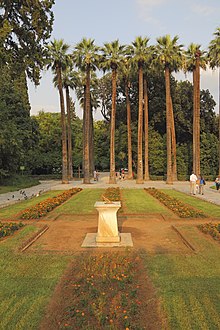National garden
The National Garden ( Greek Εθνικός Κήπος Ethnikos Kipos ) is a public garden near Syntagma Square in Athens . As a former palace garden, it borders on the former city palace and today's parliament building in the northwest, and on the Zappeion in the south . The state garden was given to the city of Athens free of charge for 90 years in 2004, and maintenance is carried out on a voluntary basis by the Politistikos Organismos “Neon” (Πολιτιστικός Οργανισμός “Νέον”, cultural association “the new one”).
history

In ancient times, part of the site was the private garden of the philosopher and botanist Theophrastus of Eresus , a successor to Aristotle . The garden was a gift from Demetrios of Phaleron to his teacher, as evidenced by a boundary stone. There was also a sanctuary and library there.
The 15.5 hectare garden was planned between 1838 and 1840 on behalf of Queen Amalie by the agronomist Friedrich Schmidt as a scientifically used botanical garden and as a private refuge. Part of the vegetation turned out to be unsuitable for the climatic conditions and was replaced. Amalie took part in the design of the garden, including planting.
In 1867 Schmidt succeeded in making the rare agave atrovirens karwinski bloom. Among other things, Schmidt grew a crocus plant, which he sent to Carl David Bouché , who successfully overwintered the latter in Germany in a cold greenhouse. He sent a cucumber plant to Friedrich Adolph Haage : "The cucumber from Athens mainly stands out as a salad cucumber that is why it never tastes bitter, whereas a mustard cucumber appears very fleshy and never furry".
The garden was expanded by the German-Greek botanist Carl Fraas . Some of the vegetation was unsuitable for the Mediterranean climate and was replaced. Archaeological finds were made during the work, including a Roman mosaic and an ancient aqueduct that was used for the garden. Queen Amalie later turned to the politics of agriculture and was no longer involved in the maintenance of the garden herself. Director of the garden was Theodor von Heldreich and its successor Spiridon Miliarakis . According to a report from 1860, the garden was open to the public in the afternoons.
In the park in 1920 King Alexander was bitten by his pet, a monkey, and then died of complications from blood poisoning. The garden was opened to the public in 1923 and renamed from the royal garden to the national garden after the end of the monarchy in 1974 . Since the layout of the garden is closely linked to Queen Amalie, the street next to the 12 palm trees she personally planted was named after her and the main entrance was moved there. Since then, the garden has been open to the public and the opening times are "from sunrise to sunset".
A small botanical museum about the history of the park, a café and a children's library are in operation. Some archaeological finds can also be seen in the park. Some busts recall personalities from the history of Greece, including one of the poet Dionysios Solomos and one of the banker Jean Gabriel Eynard . In the 1990s, the zoo in the park was greatly reduced in terms of species, as it no longer complied with current legal provisions, but necessary renovation measures would have required major changes to the substance, which was succeeded by the Attic Zoological Park . Events are also held in the park, including the Athens Gardens Festival .
literature
- Landerer: The Royal Garden of Athens . Vienna 1859 ( google.de ).
- Alexander Papageorgiou-Venetas: Amalie von Oldenburg, Queen of Greece, and the Royal Garden of Athens. P. 29–52 in: Kunst- und Kulturkreis Rastede e. V. (Ed.): Amalie: 1818-1875; Duchess of Oldenburg, Queen of Greece . Accompanying volume for the exhibition of the same name from August 29 to October 24, 2004 in the Palais Rastede; Series: Kultur im Palais , Volume 2. Isensee Verlag, Oldenburg 2004, ISBN 3-89995-122-0 .
Web links
Individual evidence
- ^ Hans Rupprecht Goette , Jürgen Hammerstaedt : The ancient Athens. A literary city guide . Beck, Munich, ISBN 3-406-51665-3 , p. 215 .
- ↑ Agaveen . In: German magazine for gardening and flower science, magazine for gardening and flower lovers and gardeners . 1867, p. 45 ( google.de ).
- ↑ Karl Koch: 497th Assembly of the Association for the Promotion of Horticulture . In: Weekly of the Association for the Promotion of Horticulture in the Königl. Prussian states for horticulture and botany . tape 12 , no. 11 , 1869, pp. 82 f . ( google.de ).
- ↑ Karl Koch: 499th Assembly of the Association for the Promotion of Horticulture . In: Weekly of the Association for the Promotion of Horticulture in the Königl. Prussian states for horticulture and botany . tape 12 , no. 15 , 1869, pp. 114 ( google.de ).
- ↑ Warsaw newspaper, issue 148-298, 1860
Coordinates: 37 ° 58 ′ 27 ″ N , 23 ° 44 ′ 18 ″ E